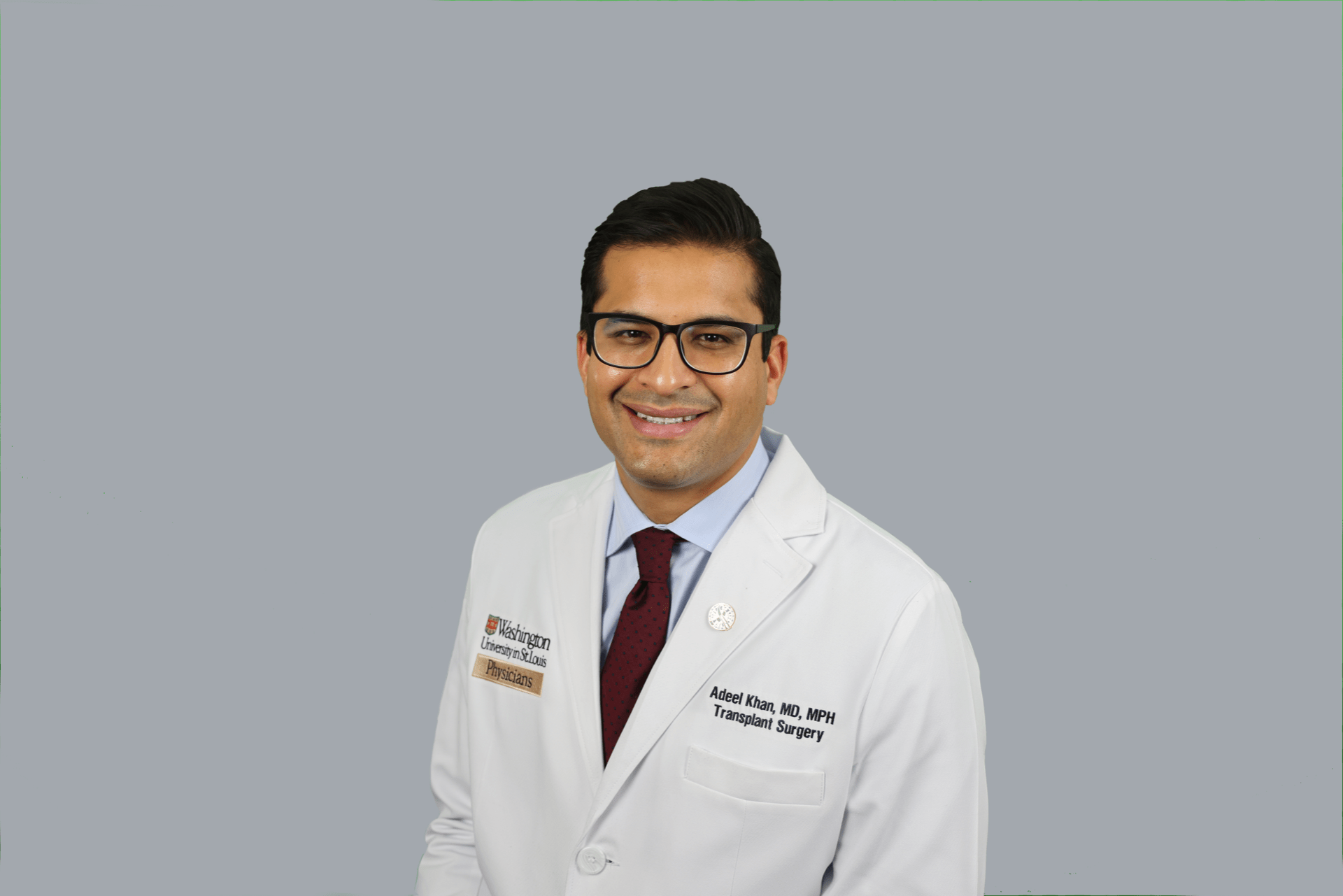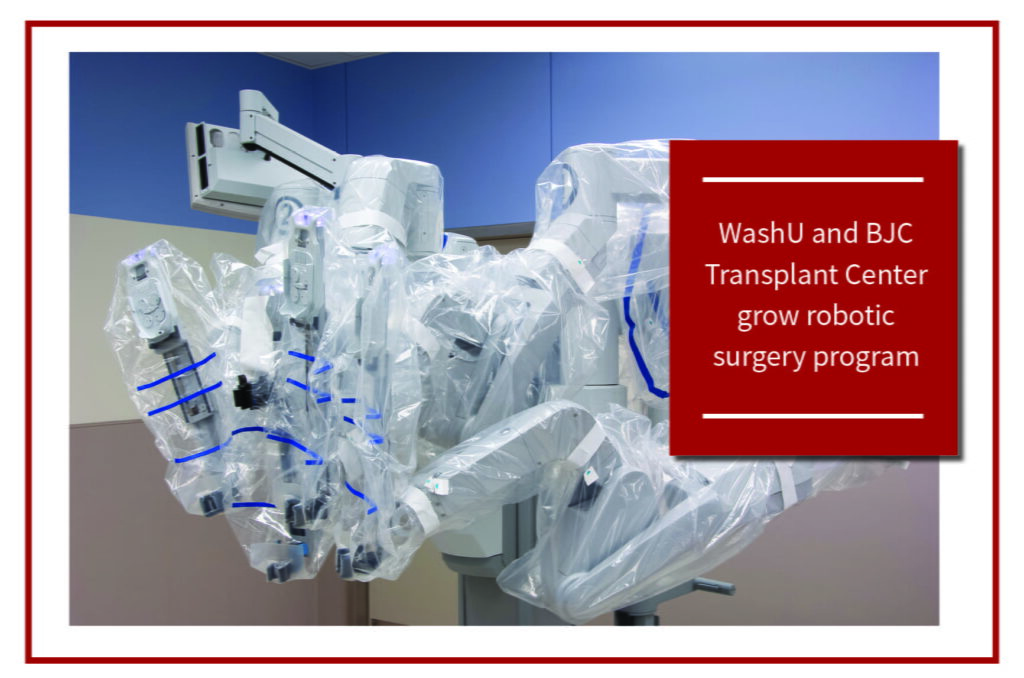Washington University School of Medicine in St. Louis has one of the largest transplant programs in the country and its transplant surgeons have always been leaders in innovative research and cutting-edge technology. The development of a robotic transplant program is the most recent addition to the Transplant Program at the School of Medicine and has allowed surgeons to use innovation to further advance the field of transplantation.
At Washington University, transplant surgeons have traditionally offered both open and laparoscopic procedures for kidney donors and recipients. With the implementation of the robotic transplant program, living donors can also have their donated kidney removed through robotic nephrectomy.
Similar to laparoscopic procedures, robotic surgery has several advantages over open surgery. Smaller incisions with minimally invasive surgery typically result in less pain, shorter length of stay, faster recovery and cosmetically more appealing scars compared to open surgery.
With laparoscopic surgery, thin, tube-like devices, called trochars, are inserted through skin incisions, and the surgeon operates using instruments that are placed through the trochars. Robotic surgery builds on the same concept, using trochars and instruments that are connected to a robot, which is completely controlled by a surgeon sitting at a console through use of hand controls. Both minimally invasive approaches are highly successful and effective, with robotic surgery potentially offering a few advantages over the laparoscopic technique. Currently, the choice of using one over the other largely depends on surgeon preference and robot availability.
Assistant Professor of Surgery Adeel Khan, MD, MPH, sees clear benefits to the robotic approach. Khan, who is a fellowship trained Transplant and Hepatobiliary (HPB) surgeon, has been at the forefront of building successful robotic programs in both disciplines. Improved 3D visualization, fine motor control and wristed motion are some of the many benefits that Khan emphasizes.
“The trochars used in laparoscopic surgery are straight, rigid instruments, almost like chopsticks,” Khan describes. “Comparing that to a robot, instead of chopsticks you have mini hands that you can control with very fine movement in perfect three-dimensional visualization. That, in my mind, sets apart robotics from minimally invasive surgery and completely changes the playing field in terms of the limits of what we can achieve”
Growing Opportunities in Transplant Surgery
The overall growth in minimally invasive procedures at the School of Medicine has enabled transplant surgeons to consider potential living kidney donors for surgery who might otherwise not be candidates for surgery.
The improved visualization and dexterity of the robotic instruments allows transplant surgeons to consider donors with abnormal anatomy, such as accessory or aberrant vessels to the kidney.
“Another advantage is for patients with obesity,” Khan asserts.
Surgeons traditionally have a weight cutoff for most operations. Beyond that limit, it can be more difficult for the patient to safely undergo a procedure. The transplant team feels that robotic surgery can expand that weight limit, allowing the surgeon to safely operate on people that might not be candidates for living donation at another center. This can have a significant impact on increasing organ availability and decreasing wait-list times for patients with renal failure who currently have to wait in excess of three years for a deceased donor. The gradual increase in the average body mass index (BMI) of the population means that fewer people would be living donation candidates each year if BMI cutoffs for surgery remain unchanged.
As the next step, transplant surgeons at Washington University are preparing to expand robotic surgery to kidney recipients.
“For recipients, there will be even greater benefits to robotic surgery. The incisions will be much smaller, which means less pain and less rates of wound complications,” Khan says. “Kidney transplant patients often have a lot of medical problems like obesity, diabetes and physical deconditioning: all of which impact wound healing. But with robotic surgery we can potentially avoid many wound complications that are so prevalent in this high-risk population.”
Transplant surgeons at the School of Medicine hope to continue growing their life-saving service by creating opportunities for more people to be eligible donors and recipients using robotic surgery.
“That’s the real beauty,” Khan says. “We are now able to offer surgery to a much larger population and hence increase the donor pool.”

Advanced Expertise in Transplant and HPB
Robotic surgery has proven beneficial in HPB as well as transplant. Khan and his colleagues in HPB surgery are able to offer the breadth of procedures—from pancreas and liver resections to gastric and bile duct operations to remove cancer—robotically.
“We get referrals for complex gallbladders that others cannot do,” Khan says. He is glad to be able to serve these people who require expert minimally invasive care. “I find the robot extremely helpful for doing those complex cases through small incisions.”
The shift to robotic surgery allows HPB surgeons to treat people with less pain and shorter hospital stays. Because the pain is lower following minimally invasive surgery, the team is able to manage pain without the use of narcotics, shortening the recovery time for many procedures.
“Many of our hepatobiliary patients are cancer patients, and the need is for them to get to chemotherapy,” Khan explains. “If they have a big operation, it takes them a longer time to recover and then to start chemo. But now we can do it through smaller incisions, recovery is faster, and we can get them to start chemotherapy sooner, which is a huge plus.”
Khan is fellowship trained in both Advanced Robotic HPB Surgery and Abdominal Transplant Surgery. This dual training has helped him treat some of the most challenging cases. The technical skills he acquired during transplant fellowship at the School of Medicine allow Khan to operate with confidence.
During his general surgery residency, Khan realized that he wanted to specialize in HPB surgery. He saw that the liver and pancreas were considered “the holy grail” for general surgeons. Whenever there was a problem with those organs, there was a specific expert who had the skill to handle the situation.
“If I put in the effort to become a surgeon, I really wanted to be that person who could handle any issue,” Khan recalls.
It was during his HPB fellowship training at Washington University School of Medicine in St Louis that Khan was introduced to transplant surgery.
“I quickly realized during my HPB fellow-ship that in many instances, when HPB surgery reached the limits of what could be done, transplant took over.”
Khan knew then that he would continue his training and specialize in transplant surgery. He aspired to become the expert who could handle the most complex problems. Abdominal transplant fellowship training at the School of Medicine was the final component to achieve that goal.
“Having training in both gives you a much broader oversight and understanding of not just the disease process but also the treatment options you can offer,” he says. “There is a spectrum of how you can manage a patient. Knowing both sides of the story—HPB and transplant—often allows you to make a decision that is best for that person.”
National Leaders
The Washington University and Barnes-Jewish Transplant Center offers a level of expertise and innovation found only among national leaders in organ transplant. Highly skilled transplant surgeons, nurse transplant coordinators and other specialists provide a comprehensive and compassionate approach to care for adults and children.
“Having a large team with different specialists allows us to be in tune with what patients need and available treatment options,” Khan says of the team. “Sometimes a person gets sent to us for a transplant evaluation, but with our expertise we can assess them and say that a lesser operation might be more appropriate.”
In other situations, the transplant team has been able to provide transplants for people who believed they had no treatment options.
The growing minimally invasive transplant program offers organ donors and recipients a wide range of benefits, including smaller incisions, less pain and scarring, shorter length of stay and faster recovery times. As robotic surgery continues to grow, Khan is hopeful that more people will be able to donate and receive organs at the Transplant Center.
“I believe that robotic surgery is the next generation laparoscopy. It offers numerous advantages for transplant and HPB surgery,” Khan says. “As robotic surgery continues to grow, fewer patients are going to require conventional larger incisions.”
